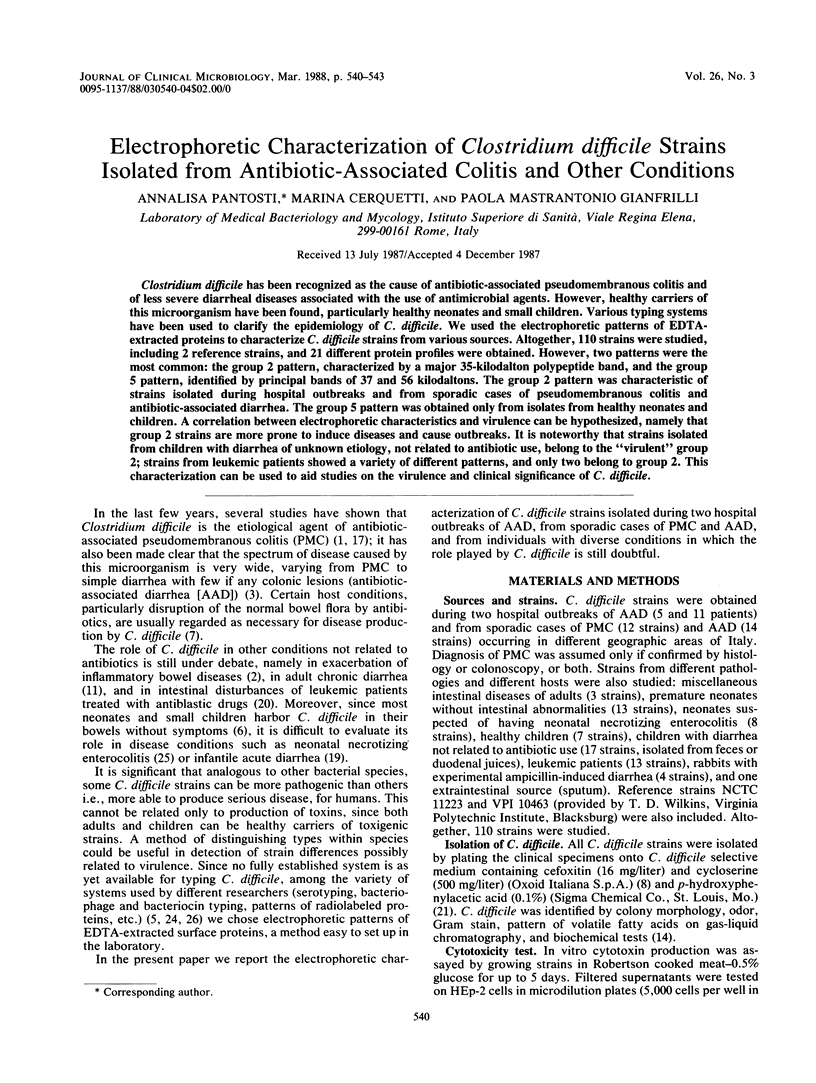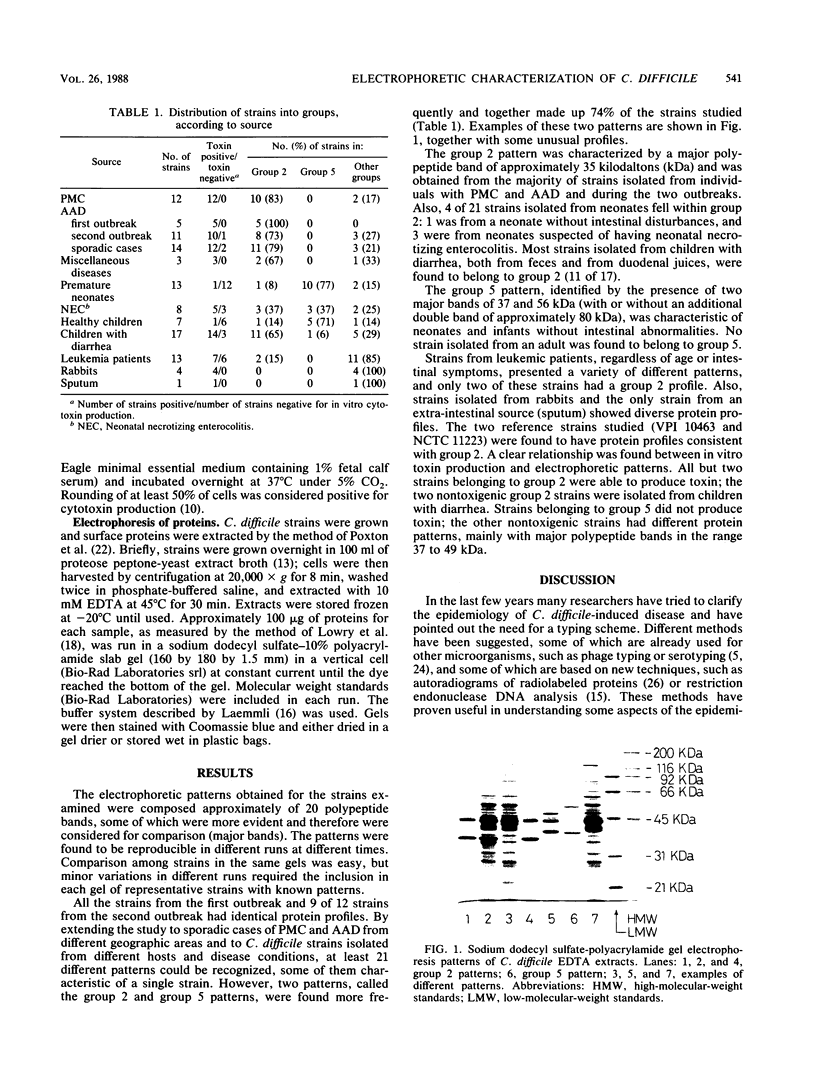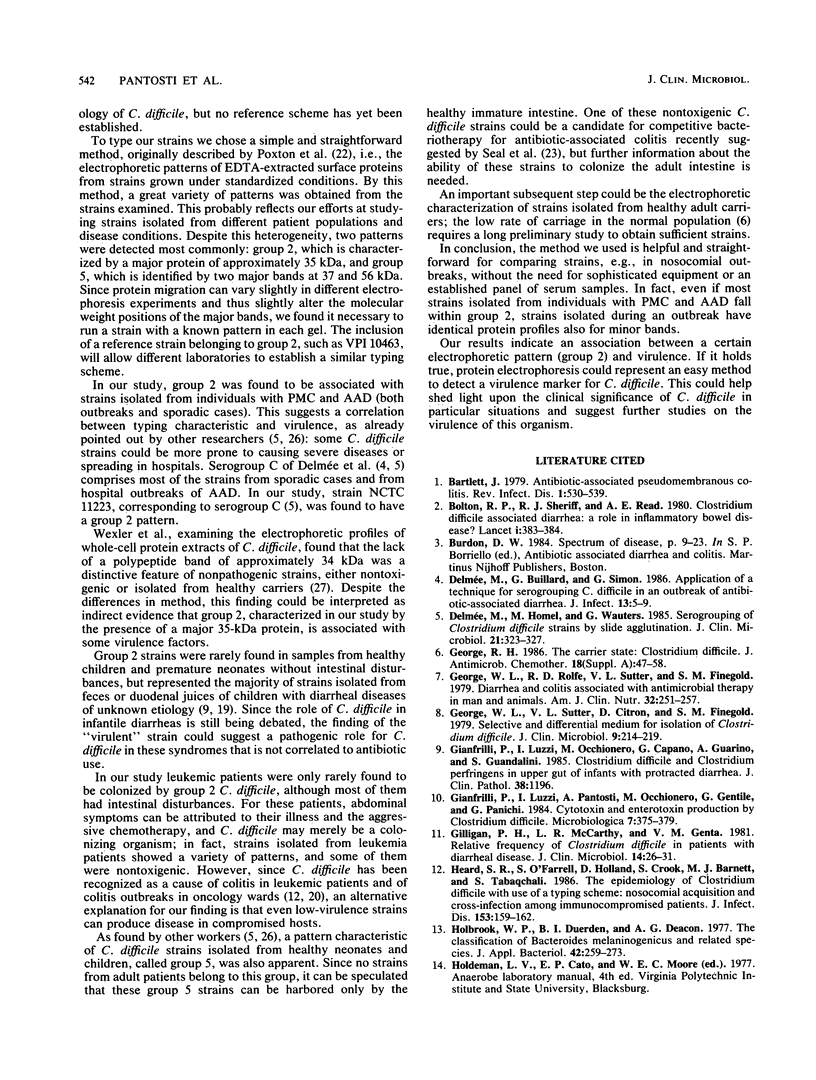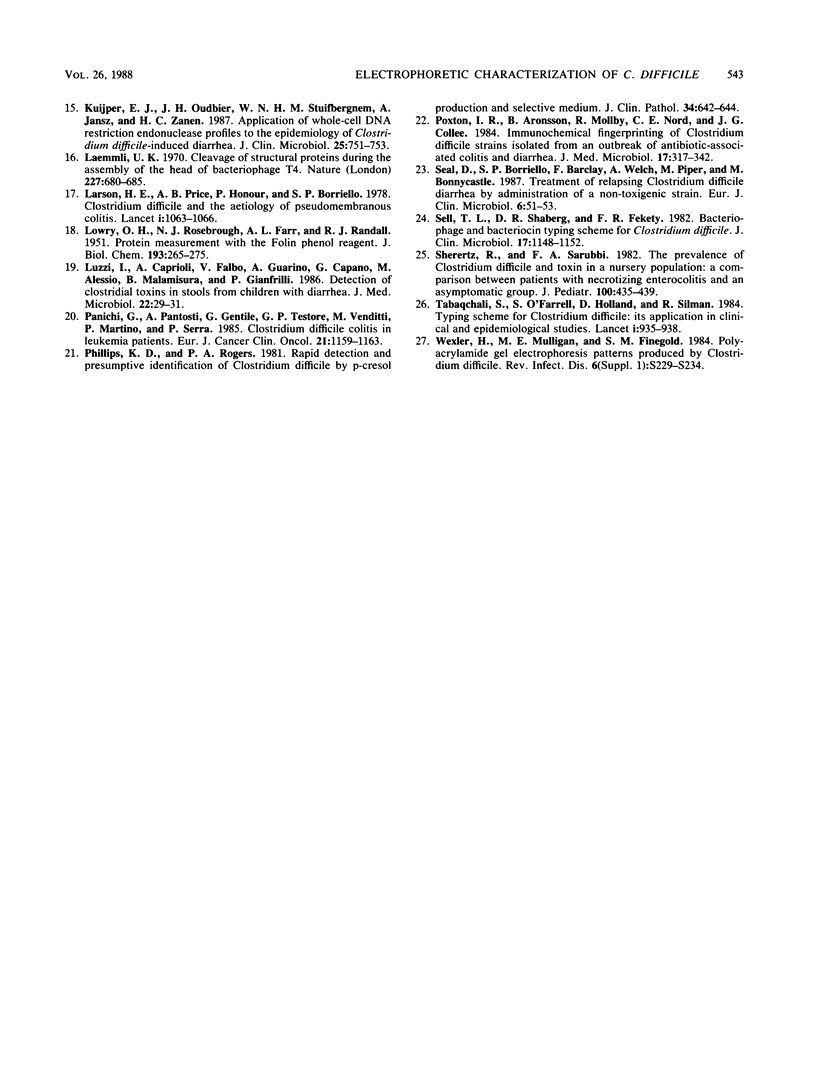Abstract
Clostridium difficile has been recognized as the cause of antibiotic-associated pseudomembranous colitis and of less severe diarrheal diseases associated with the use of antimicrobial agents. However, healthy carriers of this microorganism have been found, particularly healthy neonates and small children. Various typing systems have been used to clarify the epidemiology of C. difficile. We used the electrophoretic patterns of EDTA-extracted proteins to characterize C. difficile strains from various sources. Altogether, 110 strains were studied, including 2 reference strains, and 21 different protein profiles were obtained. However, two patterns were the most common: the group 2 pattern, characterized by a major 35-kilodalton polypeptide band, and the group 5 pattern, identified by principal bands of 37 and 56 kilodaltons. The group 2 pattern was characteristic of strains isolated during hospital outbreaks and from sporadic cases of pseudomembranous colitis and antibiotic-associated diarrhea. The group 5 pattern was obtained only from isolates from healthy neonates and children. A correlation between electrophoretic characteristics and virulence can be hypothesized, namely that group 2 strains are more prone to induce diseases and cause outbreaks. It is noteworthy that strains isolated from children with diarrhea of unknown etiology, not related to antibiotic use, belong to the "virulent" group 2; strains from leukemic patients showed a variety of different patterns, and only two belong to group 2. This characterization can be used to aid studies on the virulence and clinical significance of C. difficile.
Full text
PDF



Images in this article
Selected References
These references are in PubMed. This may not be the complete list of references from this article.
- Bartlett J. G. Antibiotic-associated pseudomembranous colitis. Rev Infect Dis. 1979 May-Jun;1(3):530–539. doi: 10.1093/clinids/1.3.530. [DOI] [PubMed] [Google Scholar]
- Bolton R. P., Sherriff R. J., Read A. E. Clostridium difficile associated diarrhoea: a role in inflammatory bowel disease? Lancet. 1980 Feb 23;1(8165):383–384. doi: 10.1016/s0140-6736(80)90940-x. [DOI] [PubMed] [Google Scholar]
- Delmee M., Homel M., Wauters G. Serogrouping of Clostridium difficile strains by slide agglutination. J Clin Microbiol. 1985 Mar;21(3):323–327. doi: 10.1128/jcm.21.3.323-327.1985. [DOI] [PMC free article] [PubMed] [Google Scholar]
- George R. H. The carrier state: Clostridium difficile. J Antimicrob Chemother. 1986 Jul;18 (Suppl A):47–58. doi: 10.1093/jac/18.supplement_a.47. [DOI] [PubMed] [Google Scholar]
- George W. L., Rolfe R. D., Sutter V. L., Finegold S. M. Diarrhea and colitis associated with antimicrobial therapy in man and animals. Am J Clin Nutr. 1979 Jan;32(1):251–257. doi: 10.1093/ajcn/32.1.251. [DOI] [PubMed] [Google Scholar]
- George W. L., Sutter V. L., Citron D., Finegold S. M. Selective and differential medium for isolation of Clostridium difficile. J Clin Microbiol. 1979 Feb;9(2):214–219. doi: 10.1128/jcm.9.2.214-219.1979. [DOI] [PMC free article] [PubMed] [Google Scholar]
- Gianerilli P., Luzzi I., Occhionero M., Capano G., Guarino A., Guandalini S. Clostridium difficile and Clostridium perfringens in upper gut of infants with protracted diarrhoea. J Clin Pathol. 1985 Oct;38(10):1196–1196. doi: 10.1136/jcp.38.10.1196-a. [DOI] [PMC free article] [PubMed] [Google Scholar]
- Gianfrilli P., Luzzi I., Pantosti A., Occhionero M., Gentile G., Panichi G. Cytotoxin and enterotoxin production by Clostridium difficile. Microbiologica. 1984 Oct;7(4):375–379. [PubMed] [Google Scholar]
- Gilligan P. H., McCarthy L. R., Genta V. M. Relative frequency of Clostridium difficile in patients with diarrheal disease. J Clin Microbiol. 1981 Jul;14(1):26–31. doi: 10.1128/jcm.14.1.26-31.1981. [DOI] [PMC free article] [PubMed] [Google Scholar]
- Heard S. R., O'Farrell S., Holland D., Crook S., Barnett M. J., Tabaqchali S. The epidemiology of Clostridium difficile with use of a typing scheme: nosocomial acquisition and cross-infection among immunocompromised patients. J Infect Dis. 1986 Jan;153(1):159–162. doi: 10.1093/infdis/153.1.159. [DOI] [PubMed] [Google Scholar]
- Holbrook W. P., Duerden B. I., Deacon A. G. The classification of Bacteroides melaninogenicus and related species. J Appl Bacteriol. 1977 Apr;42(2):259–273. doi: 10.1111/j.1365-2672.1977.tb00691.x. [DOI] [PubMed] [Google Scholar]
- Kuijper E. J., Oudbier J. H., Stuifbergen W. N., Jansz A., Zanen H. C. Application of whole-cell DNA restriction endonuclease profiles to the epidemiology of Clostridium difficile-induced diarrhea. J Clin Microbiol. 1987 Apr;25(4):751–753. doi: 10.1128/jcm.25.4.751-753.1987. [DOI] [PMC free article] [PubMed] [Google Scholar]
- LOWRY O. H., ROSEBROUGH N. J., FARR A. L., RANDALL R. J. Protein measurement with the Folin phenol reagent. J Biol Chem. 1951 Nov;193(1):265–275. [PubMed] [Google Scholar]
- Laemmli U. K. Cleavage of structural proteins during the assembly of the head of bacteriophage T4. Nature. 1970 Aug 15;227(5259):680–685. doi: 10.1038/227680a0. [DOI] [PubMed] [Google Scholar]
- Larson H. E., Price A. B., Honour P., Borriello S. P. Clostridium difficile and the aetiology of pseudomembranous colitis. Lancet. 1978 May 20;1(8073):1063–1066. doi: 10.1016/s0140-6736(78)90912-1. [DOI] [PubMed] [Google Scholar]
- Luzzi I., Caprioli A., Falbo V., Guarino A., Capano G., Alessio M., Malamisura B., Gianfrilli P. Detection of clostridial toxins in stools from children with diarrhoea. J Med Microbiol. 1986 Aug;22(1):29–31. doi: 10.1099/00222615-22-1-29. [DOI] [PubMed] [Google Scholar]
- Panichi G., Pantosti A., Gentile G., Testore G. P., Venditti M., Martino P., Serra P. Clostridium difficile colitis in leukemia patients. Eur J Cancer Clin Oncol. 1985 Oct;21(10):1159–1163. doi: 10.1016/0277-5379(85)90008-2. [DOI] [PubMed] [Google Scholar]
- Phillips K. D., Rogers P. A. Rapid detection and presumptive identification of Clostridium difficile by p-cresol production on a selective medium. J Clin Pathol. 1981 Jun;34(6):642–644. doi: 10.1136/jcp.34.6.642. [DOI] [PMC free article] [PubMed] [Google Scholar]
- Poxton I. R., Aronsson B., Möllby R., Nord C. E., Collee J. G. Immunochemical fingerprinting of Clostridium difficile strains isolated from an outbreak of antibiotic-associated colitis and diarrhoea. J Med Microbiol. 1984 Jun;17(3):317–324. doi: 10.1099/00222615-17-3-317. [DOI] [PubMed] [Google Scholar]
- Seal D., Borriello S. P., Barclay F., Welch A., Piper M., Bonnycastle M. Treatment of relapsing Clostridium difficile diarrhoea by administration of a non-toxigenic strain. Eur J Clin Microbiol. 1987 Feb;6(1):51–53. doi: 10.1007/BF02097191. [DOI] [PubMed] [Google Scholar]
- Sell T. L., Schaberg D. R., Fekety F. R. Bacteriophage and bacteriocin typing scheme for Clostridium difficile. J Clin Microbiol. 1983 Jun;17(6):1148–1152. doi: 10.1128/jcm.17.6.1148-1152.1983. [DOI] [PMC free article] [PubMed] [Google Scholar]
- Sherertz R. J., Sarubbi F. A. The prevalence of Clostridium difficile and toxin in a nursery population: a comparison between patients with necrotizing enterocolitis and an asymptomatic group. J Pediatr. 1982 Mar;100(3):435–439. doi: 10.1016/s0022-3476(82)80455-1. [DOI] [PubMed] [Google Scholar]
- Tabaqchali S., Holland D., O'Farrell S., Silman R. Typing scheme for Clostridium difficile: its application in clinical and epidemiological studies. Lancet. 1984 Apr 28;1(8383):935–938. doi: 10.1016/s0140-6736(84)92392-4. [DOI] [PubMed] [Google Scholar]
- Wexler H., Mulligan M. E., Finegold S. M. Polyacrylamide gel electrophoresis patterns produced by Clostridium difficile. Rev Infect Dis. 1984 Mar-Apr;6 (Suppl 1):S229–S234. doi: 10.1093/clinids/6.supplement_1.s229. [DOI] [PubMed] [Google Scholar]



